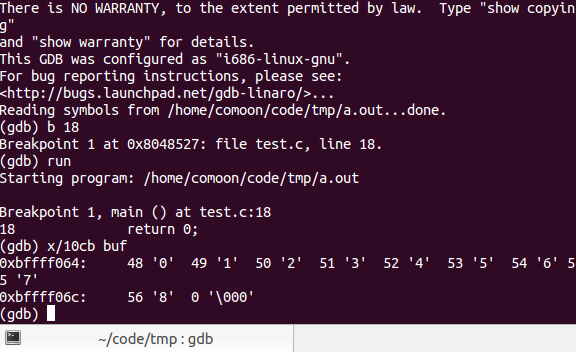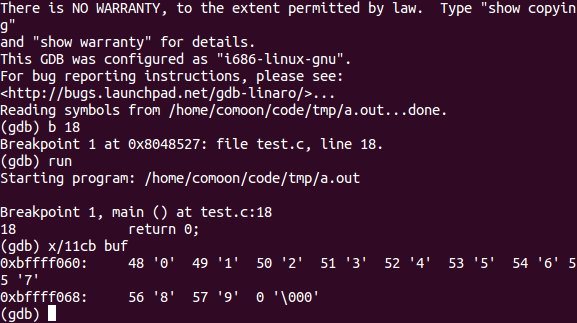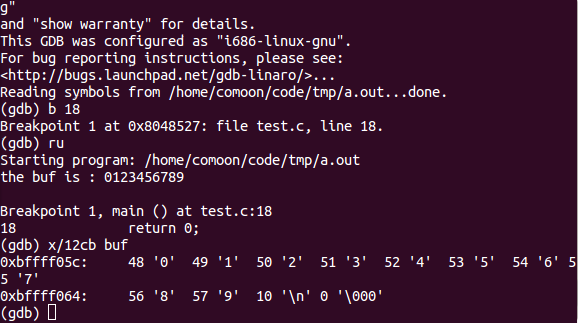完全详解fgets()函数!
来源:互联网 发布:印度2017年经济数据 编辑:程序博客网 时间:2024/05/09 04:15
关于fgets()函数的描述如下:
我们利用以下代码来测试:
外加一个测试文件叫‘data’,里面内容如下:
0123456789
0123456789
结果如下:
BUF_SIZE=10

BUF_SIZE=11

BUF_SIZE=12

代码的作用是从'data'里面读取第一行内容,我们的主要目的是看换行符是怎么被处理的。
通过上面的调试查看内存,我们可以很清楚的看到fgets()函数的行为:
缓冲区的最后一个空间总是用来存储'\0'的,也就是说实际缓冲区最多只能放n-1个字符,而换行符\n也是被看作普通字符来处理的
fgets()
Read a string of characters from a stream
Synopsis:
#include <stdio.h>char* fgets( char* buf, size_t n, FILE* fp );
Arguments:
- buf
- A pointer to a buffer inwhich fgets() canstore the characters that it reads.
- n
- The maximum number of characters to read.
- fp
- The stream from which to read the characters.
Description:
The fgets() functionreads a string of characters from the stream specifiedby fp, and stores them in thearray specified by buf.
It stops reading characters when:
- the end-of-file is reached
Or:
- a newline ('\n') character is read
Or:
- n-1 characters have been read.
The newline character isn't discarded. A null character is placedimmediately after the last character read into the array.
我们利用以下代码来测试:
#include<stdio.h>#define BUF_SIZE 10int main(){ FILE *fp; char *buf[BUF_SIZE]; if((fp=fopen("data","r"))==NULL) { printf("can't open the file!\n"); exit(1); } fgets(buf,BUF_SIZE,fp); printf("thebuf is : %s!",buf); return0;}外加一个测试文件叫‘data’,里面内容如下:
0123456789
0123456789
结果如下:
BUF_SIZE=10

BUF_SIZE=11

BUF_SIZE=12

代码的作用是从'data'里面读取第一行内容,我们的主要目的是看换行符是怎么被处理的。
通过上面的调试查看内存,我们可以很清楚的看到fgets()函数的行为:
缓冲区的最后一个空间总是用来存储'\0'的,也就是说实际缓冲区最多只能放n-1个字符,而换行符\n也是被看作普通字符来处理的
- 完全详解fgets()函数!
- fgets函数
- fgets函数
- fgets函数
- fgets 函数
- fgets函数
- fgets函数
- fgets函数
- fgets()函数
- fgets函数
- fgets函数
- fgets()函数
- fgets函数
- fgets函数
- fgets函数
- fgets函数
- fgets函数
- fgets()函数
- 小程序去掉文档左侧多余空格!
- 猕猴桃输入法开发历史
- lr中的lr_output_message,Lr_debug_message,Lr_error_message,Lrd_stmt,Lrd_fetch函数
- c#ip扫描代码
- 免费下载猕猴桃输入法
- 完全详解fgets()函数!
- 猕猴桃输入法简介
- memset、memcpy和strcpy函数使用
- 命令查看centos版本
- 一个游戏程序员的学习资料
- 排列和组合算法 C语言经典实现
- 共享内存 shm
- php导出excel格式数据
- 34


